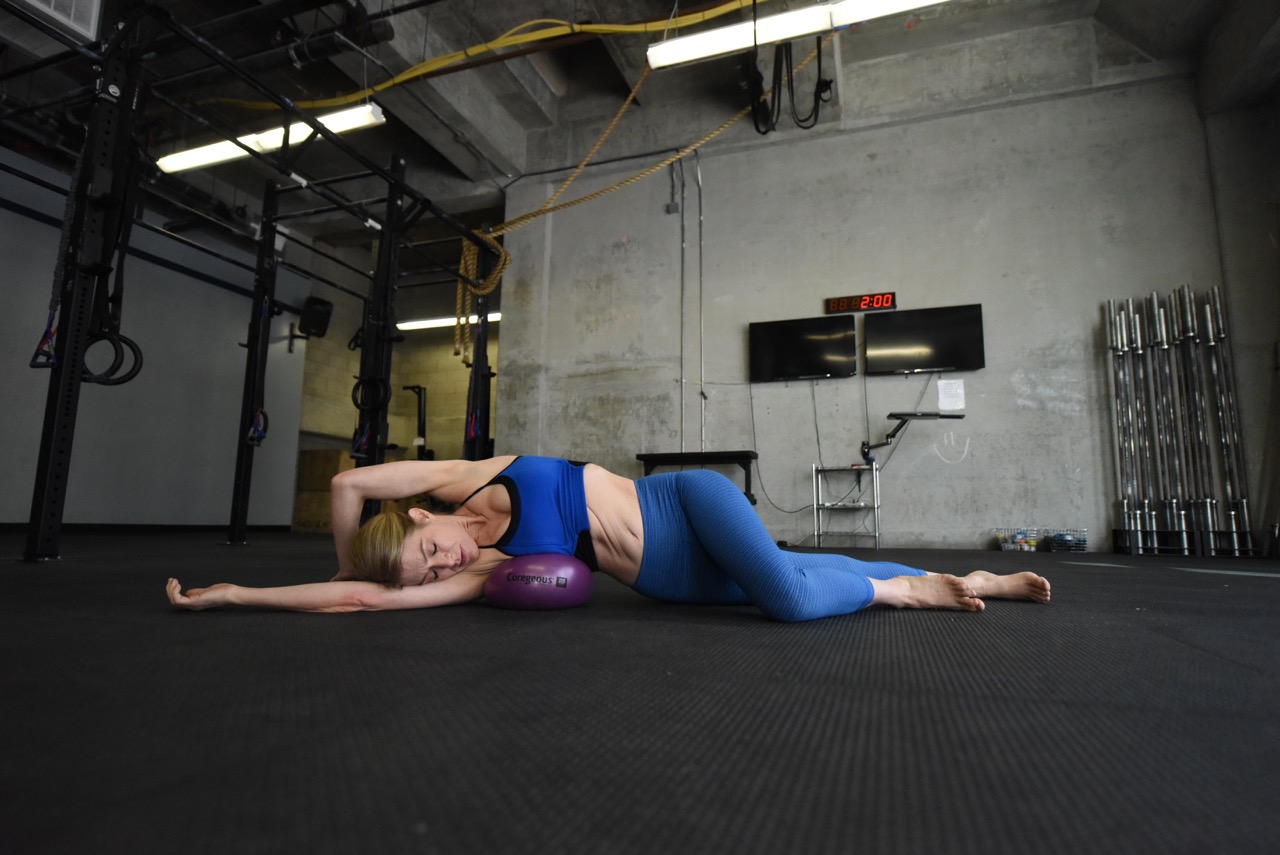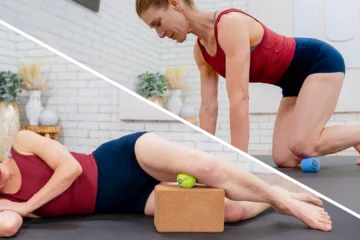
What do Louis Jackson, Kevyn McAnlis, Kelly Starrett* and twenty five million Americans all have in common? None of us can breathe….well maybe that’s being a little extreme, but we do have asthma. As mentioned in my previous blog, asthmatics suffer from chronically constricted airways, causing an over use of their secondary breathing muscles. These secondary breathing muscles are there to help when you are under attack or, more likely nowadays after a long run, but they are not meant to do the majority of breathing for you. They are there to help when the body has over exerted itself and needs to pull in more oxygen to offset the carbon dioxide being produced. They are not meant to be a primary source of breath, a job is meant for the diaphragm and external intercostals, not the muscles of the neck and back.
I met Louis Jackson in the first week of my Yoga Tune Up® training. During one of our breaks, I approached Louis about how he handles his asthma and he pointed me to the Coregeous® DVD. Along with this he suggested I practice breathing on the Coregeous® ball to help release my over worked breathing muscles. Armed with new knowledge and excited about trying out his technique, I headed home to explore.
Laying flat on my stomach, I placed the Coregeous® ball under my sternum/ribs and began to breath deeply, with each inhale pressing my chest into the ball and with every exhale allowing the ball to sink deeper into my tissues. Now, I’m not going to lie, that first breath was a little shocking. My tired body had trouble handling the extreme stretch I received as the ball burrowed it’s way between my ribs soothing and stretching into my intercostals and upper back. The amount of release I felt with each breath was amazing and when I finally came off the ball, my breathing had deepened and relaxed. That was just the beginning. I soon began researching and understanding more about my breathing habits and found ways to soothe my tired muscles.
Struggling for breath due to asthma had left me with ultra-strained secondary breathing muscles. I began practicing abdominal thoracic breathing more regularly throughout my day to help reconfigure my breathing patterns as well as working with uddiyana bandha to release and relax my diaphragm. Much like the process created with the Coregeous ball, you can use your Yoga Tune Up® therapy balls to ease the stiff breathing muscles in the neck and upper back. By placing the therapy ball right around the ‘back pack strap’ area of the upper back, you can lock into a large portion of your secondary breathing muscles, including the upper trapezius and levator scapulae. Placing the balls here and lifting your hips onto a block to increase the pressure if needed, begin to breathe deeply. Play with your breath, exploring the different ways air can enter and exit your lungs taking abdominal, thoracic and clavicular breaths. Feel free to move in any way that feels good, just be sure to keep your breath flowing and relaxed. If you roll the balls just slightly south of here, you will hit another big breathing muscle, the serratus posterior superior. This muscle lies deep to the rhomboids and can be quite pesky when aggravated. Once again play with the breath and move around as you see fit. See how to do this in the video below!
One of the amazing things about Yoga Tune Up® is how it gives us the power to alleviate muscle tension as part of our daily practice. With these simple exercises, we can unlock our secondary breathing muscles, reduce strain, and bring deep, rich, beautiful breath back into our day. (Xanax) Happy breathing!
*Read more about Kelly Starrett’s journey as an Asthma Athlete and how he used Therapy Balls to rescusistate his breath and erase debilitating wrist pain in The Roll Model by Jill Miller.
If you liked this article, read Serratus Posterior Superior, Your Unsung Breath Hero.












Looking forward to using the the YTU balls to help clients and family with mixed up, and over stressed breathing machanics.
Really informative article—Thank you! I also have asthma and have found the YTU and Coregous ball to be really helpful to open up my chest and shoulders. It is so important to create a self care routine that helps open up the body’s blind spots. Off to give this routine a try!
What a perfect follow up to your asthma explained post. As an adult, I have made running a regular part of my life and haven’t had a perceivable attack in years. If I’m honest though I probably don’t breath as well I could be, and the corgeous ball and uddiyana bandha techniques are some really easy but effective ways I could make improvements. My mom (an asthma sufferer) may not be in for uddiyana bandha, but I think I could get her to try coregeous, and christmas is right around the corner after all. You’ve given me a lot of awesome ideas to think (and breathe) on!
While I do not struggle with Asthma, I noticed that I continuously practice shallow breathing. In classes, it has been very difficult for me to hole inhalations and exhalations for the required time and often finish “om” before everyone else. When I became aware of this, I realized that my breath is not very deep because it feels like something in chest is preventing me from breathing deeper. In my daily routine, I am going to incorporate the Yoga tune up balls and see if that makes a difference! Thank you for your instructions!
Your description of the ‘back pack strap’ area to roll as support to overworked breath muscles is fantastically helpful. Great cue – and this exercise really does help to relax and build awareness of how different breaths resonate in those muscles with the balls there! Thanks for such a precise bit of information.
I am excited to learn more about using YTU to support breath and breathing. Breath regulation is often an issue with the clients that I work with. Different than the hyperactive muscles experienced by people with asthma, I work with clients with very low trunk muscle tone. They have difficulty maintaining stable sitting posture against the force of gravity. Their core and respiratory muscles are called into action for postural support. Breath is often impacted and the coordination of breath required for speech is almost impossible. i am just completing my level 1 training but eager to learn more to support complex muscle coordination and activation issues.
I, too, found the first time on the Coregeous ball to feel strange. I’m in love with it now! And exploring the back muscles and giving them attention has changed the way I view and treat the way my body breathes and moves. Although I don’t have asthma, I find these techniques are important to being able to warm up and recover from high intensity workouts. Better breathing better living!
I love that Yoga Tune Up acknowledges and teaches all of the muscles involved in breathing like the upper back. This has helped me relieve so much pain in my back/body.
I’ve been relatively fit my whole life and didn’t realize until last week in my YTU Level 1 Training, while trying to learn Uddiyana Bandha, that my muscles are so tight in my entire torso, that I can’t breathe properly! No wonder when I got really stressed years ago, the stress manifested as costochondritis. The Courageous ball is going to be my new best friend as I retrain my breathing muscles.
I have had a personal experience with asthma and it’s was essential for the funcional recovery of my breath, use the gorgeous and the yoga tune up balls in a synergy job .thanks for this post
Although I do not have personal experience with asthma, I have plenty of friends and clients who do. Many of them express a powerlessness and a desperation to do something so as not to rely so much on their inhalers during scary asthma attacks. I love that this YTU work could potentially be the preventative medicine they seek! As for the rest of us, the instruction “breathe” isn’t enough if there are biomechanical restrictions preventing us to do so in a full and healthy way. I am excited to use the YTU balls more extensively with breath as a focal point.
Thanks you!
Hi Christina,
It kind of depends on the asthmatic. If you have a trigger and know you have a trigger and are only effected by that trigger then it could be less of a constant constriction. If you have someone who does not have a definitive trigger and tends to have constant or regular asthma issues then their airways would be in more of a chronically or constant state of constriction. And yes people with asthma tend to have hyper reactive airways that in turn emit more mucous due to inflammation. Jill’s book the Role Model has an Asthma case study/story if you are looking for more information. Hope that helps!
Kevyn,
I will definitely be passing these blogs on to my daughter who suffers from asthma. Although I’ve shown her some ways to use the Coregeous and therapy balls in the past, the information here will serve as a good reminder of how helpful rolling can be. I’ve never before really thought of people with asthma having chronically constricted air passageways. I’m curious, isn’t the constriction only activated by a trigger? For example, if it was a seasonal thing like pollen, the airways could be in constant constriction for that season. But, if the trigger is cats, wouldn’t the airways only constrict when the person was exposed to cats? Or, are the airways just typically overactive and emit more mucous in those with asthma causing the constant flare?